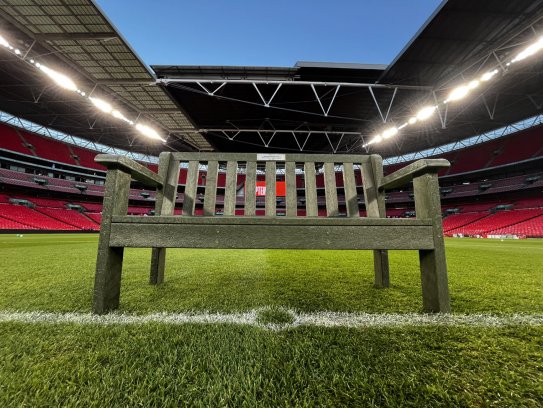
Pitch perfect with Fibresand
End-of-life hybrid pitches don’t break down naturally and are usually sent to waste landfill sites.

25th March 2024
Innovation in Textiles
|
London
A first bench has been created from the synthetic fibres and plastics recovered from the hybrid pitch of Wembley Stadium in the UK.
Many professional playing surfaces are now hybrids of nylon and other synthetics combined with grass, suitable for multi-purpose use and providing increased reliability in variable weather conditions.
The recycling of these end-of-life hybrid pitches, however, has proved a challenge, since they don’t break down naturally. As a result, the majority are sent to landfill.
“Extracting the plastic from a hybrid pitch is notoriously difficult, due to its compound structure,” says Karl Standley, grounds manager at Wembley Stadium. “When we first mooted the idea of recycling it, we were told it couldn’t be done. However, we were determined to find a sustainable answer to the problem. It’s been a long journey, involving testing and re-testing, but we have finally come up with a solution we are happy with. Creating something from a pitch that has had world class players perform on it is the ultimate memento. I am excited about what else we can possibly create in the future.”
Once a Wembley pitch has come to the end of its life, it is dug up and stored for nine months to naturally decay. Once decayed, specialist Hewitts Sportsturf separates the plastic from the sand via a screening process. The plastic is then washed and sent to waste specialist Circular 11. The plastic is shredded, extruded and strengthened with a tougher plastic – in the initial development this was plastic from old seats taken out of Wembley Stadium.
“The full circle pitch project has been one of the most technically demanding and exciting projects that we’ve worked on to date, and we’re really proud to be a part of it,” says Connor Winter of Circular 11. “It demonstrates that there are huge opportunities to increase plastic recycling when companies have unrelentingly high standards about what happens to the materials they use, and shows the potential for composite technology to transform previously unrecyclable plastic into a resource.”
“As more stadiums become multi-purpose venues hosting a variety of sports, music and entertainment shows, there is a need to use more hybrid carpet surfaces throughout the year,” Standley adds. “By ensuring old pitches don’t go to landfill we can create a cycle that will ultimately reduce our impact on the environment and benefit community clubs up and down the country for a long time to come.”
The stadium team estimates that around 50 benches could be created from one pitch.
The prototype bench will be placed within the stadium in memory of an employee who passed away last year.

Business intelligence for the fibre, textiles and apparel industries: technologies, innovations, markets, investments, trade policy, sourcing, strategy...
Find out more